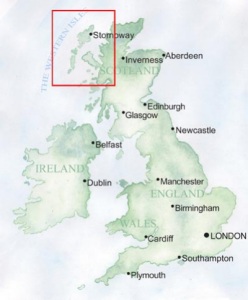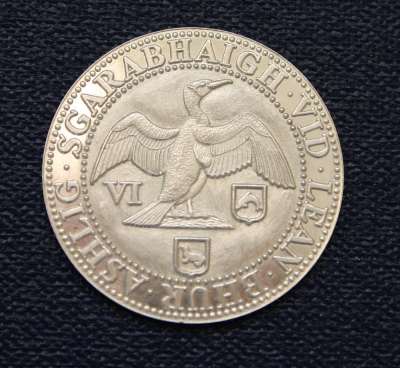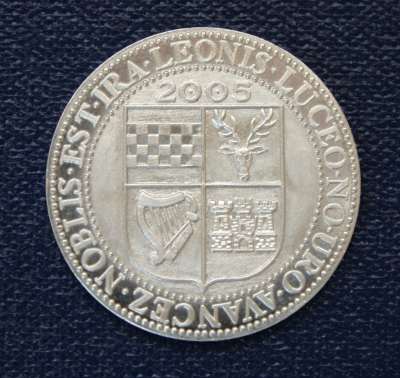by Dave
Hill
(click on photos to enlarge images)
THE SGARABHAIGH SILVER SIXPENCE
The Sgarabhaigh Sixpence forms an important part of
a wider project (Friends of Sgarabhaigh) to conserve and
share the small Scottish island of Sgarabhaigh which
lies in the beautiful Western Isles of Scotland. The
coin design is based on an ancient coin of the realm and
incorporates a blend of the ancient and modern history
of the island as well as three of the ecological
cornerstones of the place that is Sgarabhaigh. We have
minted it in 'fine' silver which is 99.9% pure silver,
rather than the harder but less pure Sterling Silver, as
it will not have to suffer the rigours of general
circulation.
The island is located in the Outer Hebrides which are
a group of islands that lie just off the north western
corner of Scotland. Sgarabhaigh (pronounced Scaravay) is
to be found at the eastern end of the Sound of Harris
that in turn lies about half way down the 150 mile long
chain of islands. Click on the map to locate the island
|
 |
The coin is based on the silver sixpence produced by James
VI of Scotland (1588-1625) also James I of England (1603-1625)
the first King to unite the crowns of Scotland and England. It
is a denomination of coinage first introduced in 1551 and was
minted up to 1967 with its final demise being part of the
decimalization of currency in the United Kingdom in 1971. The
selection of a coin from this period of Royal Union is
considered appropriate as Friends of Sgarabhaigh too is a joint
Scottish / English venture.
The coin is therefore a solid silver coin 26mm diameter and
weighing 4.5gms, the same proportions as the hand struck
sixpence coins minted up to 1662. The machine-made milled coins
made after that date reduced in size to 21mm dia and a weight of
3 gms and they in turn were changed in1816 to a 19mm diameter
2.8 gm coin. This coin would have been hand struck in 1603 as
this was the traditional method of coin production up to 1662.
We have however minted the coin using a mechanical method
employed post 1662 in order to retain the maximum detailed
definition of the features of the coin. Its detail is an amalgam
of historic and ecological elements which create what is a
unique, and we believe an accurate, representation of what is
now Sgarabhaigh.

|
The Obverse side of the coin (normally the head
side) is dedicated to the ecological aspects of the
project. It has the Cormorant with its wings spread as a
replacement for the traditional monarch's profile and,
as Sgarabhaigh, when translated from the Gaelic means 'Cormorant
Island', it was considered appropriate that it was given
the 'Sovereign's' role. Two other important species, the
seal and the dolphin, that live around the island are
illustrated in the small shields beneath the cormorant.
We have added the denomination of the coin, despite it
not being legal tender, in order to reflect the value of
the coin on which it is modeled. Consequently 'SGARABHAIGH
VID' is printed around the top outer edge of this face
of the coin. You may ask why a 'D'? Well the older ones
among you will remember the pre decimalization notation
of £, s, d where the 'd' stood for denarius or penny
from the Roman period. The denomination value is further
reinforced by the 'VI' repeated under the Cormorants
left wing just as the denomination VI was placed in the
same position on the original coin back in the early
1600's. The bottom half of the outer edge has
appropriately, the motto of Friends of Sgarabhaigh in
Gaelic 'LEAN BHUR ASHLIG' (pron. len burr ashlic) which
means, equally appropriately, 'Follow your dreams' just
as I have done with this project.
|
On the 'Reverse' side of the coin is a Shield, known
as an escutcheon, again replicating the original coin.
Within the shield we have included our historic link to
the Stuarts, the Royal House of Scotland, represented by
the Chequered Pattern in the top left hand quarter. This
pattern is central to the Stuart crest. Next we have
included a link to the family from which the island was
bought, the MacKenzies, represented by the Stags Head in
the top right hand corner of the same shield. Third is
the link to Friends of Sgarabhaigh's driving force and
sponsor Dave Hill whose family name is represented by
the Castle in the bottom right hand corner of the shield,
again a central element to their family Coat Of Arms.
Finally, to recognize the very special Celtic linkage
that Scotland has with Ireland, a link which has been
reflected in British coinage over centuries, we have
retained the Harp in the bottom left corner of the
shield. This element is from the British Royal Crest.
|
 |
The different family links are further reinforced by the
inclusion of the relevant family mottos in their Latin form set
around the main shield on the outer edge of the Reverse side of
the coin. The Stuarts motto being Noblis est ira leonis and
meaning ‘The wrath of the lion is honorable’, the MacKenzie
motto being Luceo no uro and meaning ‘I shine but not burn’ and
the Hill motto Avancez meaning simply ‘Advance’.
The meanings attributed, by historians, to the various symbols
used in the design are also an interesting aspect of the whole
coin design and project ethos. The ‘Chequered’ design from the
Stuart quadrant is considered to signify ‘Constancy’ which is a
recurrent theme of the whole of the project. The Stags Head from
the MacKenzie clan crest signifies ‘Peace and Harmony’ as well
as the commendable trait of ‘Will not fight unless provoked’
demonstrating innate strength and reflecting the peace of the
island. The Castle signifies ‘Safety’ and ‘Solidity’ key
features of the island and its safe environment free from
predators for many of the creatures that use it to rest, breed
and live on over the course of the years .The Harp brings the
more spiritual aspect of the island to the fore being taken to
signify ‘a mystical bridge between heaven and earth’ which
appears quite likely in some of the light and colour changes on
and around the island with the constantly changing weather.
Most of us are not used to seeing or touching pure silver coins
from the 1600’s with their wafer thinness, un-milled edges and
their lighter feel so we thought that the addition of a formal
hallmark would overtly validate the purity of the coin and add
‘gravitas’ to what is a most unique and unusual item. These
official registration marks underpin both the provenance of the
coin and add to its intrinsic charm with the delicacy of all
four assay marks being individually cut onto each coin after it
has been struck.
Consequently each coin is individually ‘Hallmarked’ by the
Birmingham Assay Office to guarantee its silver purity. We have
our own Sponsor Mark that has been registered with the Assay
Office.
The four elements that constitute the hallmark are located
on the ‘Reverse’ of the coin adjacent to the escutcheon (shield).
They consist of:
• A Celtic ‘FS’ which is our own registered Sponsor Mark,
• the ‘Anchor’ which is the mark of the Birmingham Assay Office
established in 1773,
• a ‘999’ assay mark proving that the silver used is pure ‘Fine’
silver,
• a ‘Britannia’ being the traditional UK symbol for silver.
The marks are laser imprinted on the coin to avoid any risk of
damage which may occur during the more physical hammer striking
process.
Thanks for reading about our coin and take care and as we say in the
islands ‘May the wind be always at your back’.
- Dave Hill -
2006
contact e-mail: dave@scaravay.com
|
|
 ASSOCIATION OF SMALL COLLECTORS OF ANTIQUE SILVER
ASSOCIATION OF SMALL COLLECTORS OF ANTIQUE SILVER ASSOCIATION OF SMALL COLLECTORS OF ANTIQUE SILVER
ASSOCIATION OF SMALL COLLECTORS OF ANTIQUE SILVER